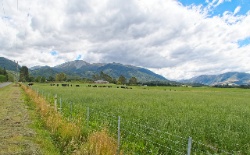Lamprey – the vampire of the sea
NIWA Media Release - Summer Series- Lamprey – the vampire of the sea
Lamprey - the vampire of the sea. A shy, slimy, ancient fish, that looks like an eel but isn’t. It has a circular sucker for a mouth, and feeds by rasping a hole in its victim’s fishy-flesh. It starts life in freshwater, spends most of its life at sea, but returns to freshwater to breed. It can be found all around New Zealand, in southern Australia, and South America.
“Lampreys are very widespread and more common than people realise. It’s just that they are very secretive and seldom seen,” says NIWA Principal Scientist Dr Don Jellyman.
Adult lampreys have large eyes, one nostril on top of the head, and gill pores on each side of their head for breathing. They range in size from 45–75 centimetres.
They are characterised by a large, toothed, funnel-like, sucking mouth. They feed on prey as adults by attaching their mouthparts to the animal's body. They don’t have a jaw, so they use an oral sucking disk, or tongue; they bore into the flesh of their prey to suck their blood and body fluids.
They are excellent climbers, and they use the suckers to climb. Surprisingly, they can climb at least 20 metres up over waterfalls.
This fish lives in both rivers and streams, and the sea. The native lamprey can also travel long distances in the open ocean.
A few things distinguish them from eels: the sucker disk for a mouth, and the seven gill pores behind the head. Male adult lampreys also develop a large pouch just behind their mouths.
Lampreys migrate into rivers in late winter and spring. When they journey from the sea, lampreys are bright silver with two–blue racing stripes along the length of their body, but soon change to a drab dark grey colour in freshwater.
Lampreys stay in freshwater for about 18 months, from the time they arrive to when they spawn. The adults do not feed while in freshwater. Scientists think that juvenile lampreys spend up to four years in freshwater, before migrating to the sea.
The juveniles are a muddy brown colour, and look like small eels. However, they are different from eels by having seven gill openings and no eyes. As they approach migration, juvenile lampreys develop eyes, and change to a bright silver with two–blue racing stripes on them, just like the adults, but are miniature versions, at 100 mm long.
Relatively little is known about the biology of our indigenous lamprey species, Geotria australis, even though they comprise an important traditional fishery for Māori communities.
Although adult lampreys spend an extended period of time in freshwater during their upstream migration to spawning grounds, they are rarely seen. “They probably burrow into streambeds,” says Dr Jellyman, “and they hang out in debris areas under logs”.
NIWA fisheries scientists are currently evaluating whether ‘pheromones’ (a chemical compound), can be used to identify lamprey populations and spawning streams, and the ability of pheromones to attract lamprey to areas with depleted populations.
About Dr Don Jellyman:
NIWA Principal
Scientist Dr Don Jellyman has been studying lamprey for ten
years and eels for upwards of forty years. Currently he is
looking at improving methods for assessing shortfin eel
populations in lowland lakes in New Zealand. Dr Jellyman is
also involved in studying the behaviour of migrating eels in
Lake Manapouri, with a view to maximising their opportunity
to escape to sea.
To illustrate this story:
Download
photos from http://ftpmedia.niwa.co.nz/summer_series/Lamprey/
Common
names: Lamprey
Māori name: Piharau (North Island) ,
kanakana (South Island)
Scientific name: Geotria
australis
Type:
Fish
Family: Geotriidae
Size: 45–75 cm
Lifespan:
4 years in freshwater: could be up to 10 years.
Diet: Blood and host’s juices
Reproduction: The
young are born in rivers, live in coastal ocean as adults,
and return to the rivers to breed.
Things you need to
know: They are a very ancient fish that surprisingly
don’t have any bones
Something strange: The sucker-like mouth


 Fix & Fogg: NASA Hand-picks Kiwi Nut Butter Brand To Travel To Space In NZ First
Fix & Fogg: NASA Hand-picks Kiwi Nut Butter Brand To Travel To Space In NZ First Citizens of the Sea: Sailors To Revolutionise Our Understanding Of Pacific Biodiversity
Citizens of the Sea: Sailors To Revolutionise Our Understanding Of Pacific Biodiversity Netsafe: Making A Splash With Online Safety: Netsafe Launches New Flagship Programme For Kids
Netsafe: Making A Splash With Online Safety: Netsafe Launches New Flagship Programme For Kids NZGBC: Flood Resilience PhD Student Widi Auliagisni Named Future Thinker Of The Year 2024
NZGBC: Flood Resilience PhD Student Widi Auliagisni Named Future Thinker Of The Year 2024 Business Canterbury: European Free Trade Agreement A Game-changer For Canterbury
Business Canterbury: European Free Trade Agreement A Game-changer For Canterbury Business Canterbury: Urges Council To Cut Costs, Not Ambition For City
Business Canterbury: Urges Council To Cut Costs, Not Ambition For City



